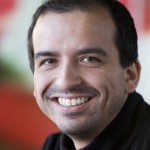Seminar: Design for Research
In this seminar we will discuss how designers in the academia can meet their design background with the academic challenges.
The seminar will be held in the Zuiletang tea house on the Yuantouzhu Peninsula of the Tai Lake.
Design research in the academic context: practice vs scholarship
prof. Steven Kyffin
Dean of the Faculty of Arts, Design and Social Sciences, Northumbria University
Many of us have experienced that the notion of Design Research has often been the cause of much conflict, creative conflict, in both the Academic and the Commercial contexts alike. Design is a Research activity in itself. So, what does Design Research mean to us in Academia and in the 21st Century?
How do we understand these concepts, how do we make sense of them and how do we contribute to Transforming our futures; the future of our people, the future of our world and the future of our Discipline while at the same time, being and acting as a Designer?
Ever since I joined the Royal College of Art in 1981 I have experienced something of the paradox, which the notion of ‘Research’ proposes: one the one hand an activity, which seeks to UNDERSTAND the world more fully through Objective Scientific Objective Experimentation in Laboratory contexts, while on the other hand the other strives to CHANGE the world through often Subjective, Exploration in Community contexts. At a dangerously simplistic level, one appears to be an act of Creation through Practice and the other an act of Scholarship through Study, and yet somehow we can bring them together.
Both the Analytical and the Synthetical approaches do of course come together of course as I believe that we are all Creative and as such have a desire to create a ‘better’ world for the future. But none the less the two approaches do set up a tension in the academic contexts, which in time I believe can become a ‘most creative’ one from which we can all grow!
This is is something that I’d like to discuss during this seminar while at the same time sharing some examples of the work we create as part of our Design Research Programmes at Northumbria University.
 Professor Steven Kyffin (Master of Design, Industrial Design, Royal College of Art, London & Honorary Doctorate Northumbria, Newcastle) is Executive Dean of the Faculty of Arts, Design and Social Sciences at Northumbria University, Newcastle in the United Kingdom.
Professor Steven Kyffin (Master of Design, Industrial Design, Royal College of Art, London & Honorary Doctorate Northumbria, Newcastle) is Executive Dean of the Faculty of Arts, Design and Social Sciences at Northumbria University, Newcastle in the United Kingdom.
In this function he is responsible for all aspects of the management of the Faculty, one of four in the University. From 2010 until 2012, Steven was Dean of the School of Design within Northumbria. Northumbria Design focuses it teaching programs on Fashion, Communication, Industrial and innovation Design across its Undergraduate and postgraduate programs. Design Innovation is one of the three core Research territories of the school. The others include; The future Roles of Design in Socio-Economic contexts and Design Futures; a Design led exploration of future qualities on Life in the Health and Wellbeing and Digital Life contexts.
Kyffin’s own Research has focused on multi and trans disciplinary Innovation in general and in particular on the roles, which Experience Design and prototyping can play in leading the Business and Social Innovation processes.
Steven previously held the post of Senior Global Director of Design Research and Innovation at Philips Design in the Netherlands. He was responsible for Design Research for Philips Electronics world-wide.
As a member of the Philips Design Global Management Team, Steven headed up Philips Design’s European Commission Research Relations Programme and led the Philips Design University Relations Programme.
Steven Kyffin is a member of Northumbria University’s Executive Management Team, acts as a European Commission research program reviewer and holds Adjunct Professorships in the schools of Design at Hong Kong Polytechnic University and at JiangNan University, Wuxi, China.
Product semantics: Quo Vadis.
prof.dr.ir Loe Feijs
Department of Industrial Design, Eindhoven University of Technology, The Netherlands
Product semantics is a central theme in the field of Industrial Design. Forms, either abstract or concrete always carry meanings. It is the responsibility of designers to make good use of the possibilities of these meanings. It is important for designers to have access to and a full understanding of the structure of product semantics and the relevant types of knowledge so that they can effectively communicate and help users to effectively communicate. In this presentation I will review a number of classical theories about product semantics – mostly Western theories. These include the notions coming from semiotics, such as the work of Charles Peirce and Umberto Eco. We shall go back the classic sender-receiver model of Claude Shannon, next to achievements of the Offenbach school of product semantics and compare these with the more recent semantic turn by Klaus Krippendorff. In engineering traditions such as computer science, formalization has always been a first step towards making more powerful tools and in this context my own Commutative Product Semantics (CPS) will be explained. Then I will introduce the terminology of closed and open semantics. Whereas closed semantics is based on Peirce’s and Shannon’s classic ideas, open semantics is about designs which work as a medium, a carrier, or a tool. Open semantics allows the user to put his or her own meanings into the design and connect these to new rituals. Product semantics becomes a participatory process. When talking about media, the theories of McLuhan are helpful too. I shall argue that open and closed semantics both play and essential role, usually even within a single design. All concepts will be illustrated by classic and contemporary examples. The last part of the presentation will be about the future of product semantics. Questions addressed include: What is the impact of Social Computing upon the field of product semantics? Why do most of our design tools not have any semantic knowledge embedded? Can we deploy Semantic Web technologies to advance the field of product semantics?
 Loe Feijs (The Netherlands, 1954) is professor of Industrial Design at Eindhoven University of Technology. He holds a Master’s degree in Electrical Engineering and a Doctor degree in computer science. He has worked on formal methods in Philips Research Laboratories, he was director of the Eindhoven Embedded Systems Institute and Vice dean of TU/e ID. At present he holds the chair Industrial Design of Embedded Systems. He teaches topics such as Integrating Technology and Creative Programming. His research interests include creative programming, product semantics, design for neonatology, medical simulation and biofeedback.
Loe Feijs (The Netherlands, 1954) is professor of Industrial Design at Eindhoven University of Technology. He holds a Master’s degree in Electrical Engineering and a Doctor degree in computer science. He has worked on formal methods in Philips Research Laboratories, he was director of the Eindhoven Embedded Systems Institute and Vice dean of TU/e ID. At present he holds the chair Industrial Design of Embedded Systems. He teaches topics such as Integrating Technology and Creative Programming. His research interests include creative programming, product semantics, design for neonatology, medical simulation and biofeedback.
The interplay of design practice and design research
Dagmar Steffen
Lucerne University of Applied Sciences and Arts, School of Art and Design (Switzerland)
The relationship of scientific research in the field of design and design practice was and still is under debate. For many decades, both activities were strictly separated, but during the last two decades an increasing number of universities of art & design around the world introduced so-called practice-led design research or “research through design”. In my talk I will focus on three issues. Firstly, I will argue, that the inclusion of material practice (“doing & making”) in scientific research is not specific to design; indeed, in various disciplines material practice has a long tradition (i.e. medicine, physics and archaeology) and inevitably contributes to knowledge creation. Nonetheless the role or function of practice in practice-led design research (including doctoral research) demands closer examination and justification. Thus, secondly I will elaborate the commonalities of and the differences between material practice resp. the role of the artefact in research in the before mentioned disciplines and in design research (the design object: as an experimental, hypotheses-testing or explorative artefact; as a non-discursive symbolism; as a work in its own right). Finally I will argue, that the interplay of design practice and design theory as it takes place in practice-led design research creates a mindset that is beneficial for the discipline in general and especially for design education since it contributes to bridging the gap between unconsidered design practice on the one hand and abstract design theory, bereft of any relevance for practice on the other.
 Dagmar Steffen is a researcher and lecturer at the Lucerne University of Applied Sciences and Arts, School of Art and Design (Switzerland). She works primarily in the areas of product semantics, design and innovation and design and sustainability. She studied Product Design at the Academy of Art and Design Offenbach (Germany) and at the Edinburgh College of Art (UK). From 2000-2003 she has been a member of the research staff at the Academy of Art and Design Offenbach; from 2004-2007 she was a visiting lecturer at the Bergische University Wuppertal (Germany), while joining part-time the SeFun (Semantic Functions in Design) research project at the Aalto University School of Art and Design (Finland). She is author of numerous publications (books, articles and conference papers) and holds a PhD.
Dagmar Steffen is a researcher and lecturer at the Lucerne University of Applied Sciences and Arts, School of Art and Design (Switzerland). She works primarily in the areas of product semantics, design and innovation and design and sustainability. She studied Product Design at the Academy of Art and Design Offenbach (Germany) and at the Edinburgh College of Art (UK). From 2000-2003 she has been a member of the research staff at the Academy of Art and Design Offenbach; from 2004-2007 she was a visiting lecturer at the Bergische University Wuppertal (Germany), while joining part-time the SeFun (Semantic Functions in Design) research project at the Aalto University School of Art and Design (Finland). She is author of numerous publications (books, articles and conference papers) and holds a PhD.
How practicing designers can engage in academic research
Dr Edgar Rodriguez
Victoria University of Wellington
With the move in many countries to assess academics according to their research performance in measurable ways, many design practitioners moving to academia have faced the challenge of justifying their practice as research. This has had several outcomes. Firstly, some highly skilled designers receive low assessments as their practice is not considered research, which in turn discourages them to work in academia and it also discourages academic institutions to hire them. Secondly, some highly skilled designers reframe their activities and produce other kinds of academic research outputs (i.e. journal articles) to the detriment of their practice. Thirdly and most challenging, some highly skilled designers frame their practice around well-defined research questions that can only be answered through the practice of design. Their outputs are sophisticated designs that add new tacit and explicit knowledge to the discipline. These designers need research and practice skills that, while unusually taught together, can benefit the academic and practice areas of the discipline and bring them together to fill a gap that shouldn’t exist.
Through examples of design and research work, this seminar will discuss how the practice of design produces knowledge, why academia expects research to produce explicit knowledge and how practicing designers can engage in academic research without compromising the quality of their practice.
 Dr Edgar Rodriguez is the Programme Director in Industrial Design at the School of Design, Victoria University of Wellington, New Zealand. His career as industrial designer includes working for design studios Sismo Design (Paris), MDA (Mexico City), Studio Santachiara (Milan) and Samsung Electronics (Seoul). He has produced designs that include furniture, lighting, digital cameras, TV sets, wearable computers, medical devices and experimental designs. He has exhibited and published his research in dozens of international conferences and exhibitions. His current research studies how human data including physiological responses, behaviour and emotions can be studied to design smart interactions that help people improve their lives.
Dr Edgar Rodriguez is the Programme Director in Industrial Design at the School of Design, Victoria University of Wellington, New Zealand. His career as industrial designer includes working for design studios Sismo Design (Paris), MDA (Mexico City), Studio Santachiara (Milan) and Samsung Electronics (Seoul). He has produced designs that include furniture, lighting, digital cameras, TV sets, wearable computers, medical devices and experimental designs. He has exhibited and published his research in dozens of international conferences and exhibitions. His current research studies how human data including physiological responses, behaviour and emotions can be studied to design smart interactions that help people improve their lives.
Meddling or helpful? The Semantics of Decision Support UIs
The spiralling costs of healthcare are creating a need for medical products and systems which can be used by less trained staff or even by patients themselves. At Philips Design, this has led to an increased interest in ‘clinical decision support’ (CDS). The common understanding of CDS systems is that they assist physicians and other health professionals with decision making tasks, such as making a diagnosis based on patient data. However, we are interested in applying the concept of CDS not only to diagnostics for healthcare professionals but also to consumers struggling to make healthy choices.
An often neglected aspect is how user interfaces can offer CDS to the user. Through an analysis of many decision support UI examples from fields other than healthcare, I would like to show that there are different levels of decision support, from merely offering information which helps informed decisions, via guidance which nudges the user towards particular behaviour or choices, upto pro-active identification and correction of poor decisions. The semantics of the design execution of such CDS Uis largely determine whether CDS is experienced as meddling and misinformed or quietly helpful and intelligent.
 Tom Djajadiningrat is creative director innovation design at Philips Design. In his role as leading co-creator in a team of complementary disciplines, his focus is on helping Philips re-position itself as a Health & Well-being company. Prior to joining Philips, he worked in academia at the ID-StudioLab of Delft University of Technology, The Mads Clausen Institute of the University of Southern Denmark and the Design IntelligenceGroup of Eindhoven University of Technology.
Tom Djajadiningrat is creative director innovation design at Philips Design. In his role as leading co-creator in a team of complementary disciplines, his focus is on helping Philips re-position itself as a Health & Well-being company. Prior to joining Philips, he worked in academia at the ID-StudioLab of Delft University of Technology, The Mads Clausen Institute of the University of Southern Denmark and the Design IntelligenceGroup of Eindhoven University of Technology.
Academic Publications For Designers
The number of published papers is one of the main key performance indicators for academics. Designers working at a university have to live up to this expectation, but struggle with translating their research output into disseminations that are being recognized by colleagues from different disciplines. To make things worse, it has been shown that the academic publication process has some fundamental flaws that inhibit the publication of innovative ideas. I will reflect on some of the underlying problems of putting design work into the scientific context and will present insights into how we can overcome some of the issues of the academic publication process.
Dr. Christoph Bartneck is an associate professor and director of postgraduate studies at the HIT Lab NZ of the University of Canterbury. He has a background in Industrial Design and Human-Computer Interaction, and his projects and studies have been published in leading journals, newspapers, and conferences. His interests lie in the fields of Social Robotics, Design Science, and Multimedia Applications. He has worked for several international organizations including the Technology Centre of Hannover (Germany), LEGO (Denmark), Eagle River Interactive (USA), Philips Research (Netherlands), ATR (Japan), Nara Institute of Science and Technology (Japan), and The Eindhoven University of Technology (Netherlands). Christoph is a member of the New Zealand Institute for Language Brain & Behavior, the IFIP Work Group 14.2 and ACM SIGCHI.
[youtube]http://www.youtube.com/watch?v=u2sn87Jp3ic[/youtube]

